Carbon Balance Matching Relationships and Spatiotemporal Evolution Patterns in China’s National-Level Metropolitan Areas
Abstract
1. Introduction
2. Materials and Methods
2.1. Study Area
2.2. Research Data
2.3. Research Methods
2.3.1. Carbon Balance Coefficient Analysis
2.3.2. Carbon Balance Type Classification
- LCCZ: This indicates that the region’s ECC exceeds its carbon emissions contribution, and its ESC also exceeds carbon emissions. This zone has high carbon emission economic efficiency and strong ecological support capacity.
- CSDZ: This indicates that the region’s ECC is lower than its carbon emissions contribution, but its ESC exceeds carbon emissions, suggesting a strong ecological support capacity.
- COZ: This indicates that the region’s ECC is lower than its carbon emissions contribution, and its ESC is also lower than carbon emissions, with both low-carbon emission economic efficiency and weak ecological support capacity.
- EDZ: This indicates that the region’s ECC is higher than its carbon emissions contribution, but its ESC is lower than its carbon emissions. This zone has high carbon emission economic efficiency but weak ecological support capacity.
- DI Model: Both coefficients have positive change intensities, indicating that the carbon emission increase effect driven by economic growth is more pronounced, while the ecosystem’s carrying capacity is also improving.
- CSIR Model: Economic activities contribute less to carbon emissions, while the ecosystem’s carrying capacity is increasing (this is the ideal state).
- DR Model: Economic activities contribute less to carbon emissions, and the ecosystem’s carrying capacity is also decreasing.
- EGRS Model: Economic activities contribute more to carbon emissions, while the ecosystem’s carrying capacity is decreasing.
3. Results
3.1. Spatiotemporal Evolution of Carbon Balance in National-Level Metropolitan Areas
3.1.1. Spatiotemporal Evolution of Carbon Emissions in National-Level Metropolitan Areas
3.1.2. The Spatiotemporal Evolution Characteristics of Carbon Sequestration in National-Level Metropolitan Areas
3.2. Evolution of Carbon Balance Patterns in National-Level Metropolitan Areas Based on Economic Contributive Coefficient and Ecological Support Coefficient
3.2.1. Spatiotemporal Evolution Characteristics of Economic Contributive Coefficient
3.2.2. Spatiotemporal Evolution Characteristics of Ecological Support Coefficient
3.3. Carbon Balance Matching Relationship of National-Level Metropolitan Areas Based on Economic Contributive Coefficient and Ecological Support Coefficient
3.3.1. Static Classification
3.3.2. Dynamic Classification
4. Discussion
4.1. Spatiotemporal Evolution Patterns of Carbon Emissions and Sequestration in China’s National-Level Metropolitan Areas
4.2. Carbon Balance Matching Relationship in China’s National-Level Metropolitan Areas
4.3. Low-Carbon Pathways of National-Level Metropolitan Areas Based on the Carbon Balance Classification Method
4.4. Limitations and Future Outlook
5. Conclusions
Author Contributions
Funding
Data Availability Statement
Conflicts of Interest
Abbreviations
| ECC | Economic Contributive Coefficient |
| ESC | Ecological Support Coefficient |
| LCCZ | Low-Carbon Conservation Zone |
| CSDZ | Carbon Sink Development Zone |
| COZ | Comprehensive Optimization Zone |
| EDZ | Economic Development Zone |
| DI | Dual Increase Model |
| CSIR | Carbon Sink Increase with Economic Reduction Model |
| DR | Dual Reduction Model |
| EGRS | Economic Growth with Carbon Sink Reduction Model |
References
- Mancini, M.S.; Galli, A.; Niccolucci, V.; Lin, D.; Bastianoni, S.; Wackernagel, M.; Marchettini, N. Ecological Footprint: Refining the carbon Footprint calculation. Ecol. Indic. 2016, 61, 390–403. [Google Scholar] [CrossRef]
- Evro, S.; Oni, B.A.; Tomomewo, O.S. Global strategies for a low-carbon future: Lessons from the US, China, and EU’s pursuit of carbon neutrality. J. Clean. Prod. 2024, 461, 142635. [Google Scholar] [CrossRef]
- Piao, S.; Fang, J.; Ciais, P.; Peylin, P.; Huang, Y.; Sitch, S.; Wang, T. The carbon balance of terrestrial ecosystems in China. Nature 2009, 458, 1009–1013. [Google Scholar] [CrossRef]
- United Nations Framework Convention on Climate Change. THE PARIS AGREEMENT. Available online: https://unfccc.int/sites/default/files/chinese_paris_agreement.pdf (accessed on 8 September 2024).
- United Nations. United Nations Framework Convention on Climate Change. Available online: https://unfccc.int/sites/default/files/convchin.pdf (accessed on 9 January 2024).
- United Nations. Kyoto Protocol. Available online: https://unfccc.int/resource/docs/convkp/kpchinese.pdf (accessed on 12 October 2024).
- UN Environment Management Group. Moving Towards a Climate Neutral UN The UN System’s Footprint and Efforts to Reduce It. 2009. Available online: https://www.icao.int/environmental-protection/Documents/CNUN_report_09.pdf (accessed on 9 January 2024).
- Kassai, J.R.; Feltran-Barbieri, R.; Carvalho, L.N.; Cintra, Y.C.; Afonso, L.E.; Foschine, A. The Environmental balance sheet of nations: Reflections on global climate change scenarios. Braz. Bus. Rev. 2012, 9, 60–102. [Google Scholar] [CrossRef][Green Version]
- Hahn, T.; Morfeldt, J.; Höglund, R.; Karlsson, M.; Fetzer, I. Estimating countries’ additional carbon accountability for closing the mitigation gap based on past and future emissions. Nat. Commun. 2024, 15, 9707. [Google Scholar] [CrossRef]
- Guo, R.; Zhao, Y.; Shi, Y.; Li, F.; Hu, J.; Yang, H. Low carbon development and local sustainability from a carbon balance perspective. Resour. Conserv. Recycl. 2017, 122, 270–279. [Google Scholar] [CrossRef]
- Yue, C.; Xu, M.; Ciais, P.; Tao, S.; Shen, H.; Chang, J.; Li, W.; Deng, L.; He, J.; Leng, Y.; et al. Contributions of ecological restoration policies to China’s land carbon balance. Nat. Commun. 2024, 15, 9708. [Google Scholar] [CrossRef]
- Shigeto, S.; Yamagata, Y.; Ii, R.; Hidaka, M.; Horio, M. An easily traceable scenario for 80% CO2 emission reduction in Japan through the final consumption-based CO2 emission approach: A case study of Kyoto-city. Appl. Energy 2012, 90, 201–205. [Google Scholar] [CrossRef]
- Guo, H.; Sun, W. Carbon Balance Zoning and Spatially Synergistic Carbon Reduction Pathways—A Case Study in the Yangtze River Delta in China. Land 2024, 13, 943. [Google Scholar] [CrossRef]
- Wu, J.; Liu, C.; Guo, H.; Li, P.; Sun, W. Examining intra-city carbon budget and carbon balance zoning based on firm-level big data: A case study of Nanjing, China. Ecol. Indic. 2024, 166, 112304. [Google Scholar] [CrossRef]
- Li, J.; Guo, X.; Chuai, X.; Xie, F.; Yang, F.; Gao, R.; Ji, X. Reexamine China’s terrestrial ecosystem carbon balance under land use-type and climate change. Land Use Policy 2021, 102, 105275. [Google Scholar] [CrossRef]
- Tian, H.; Melillo, J.; Lu, C.; Kicklighter, D.; Liu, M.; Ren, W.; Xu, X.; Chen, G.; Zhang, C.; Pan, S.; et al. China’s terrestrial carbon balance: Contributions from multiple global change factors. Glob. Biogeochem. Cycles 2011, 25, GB1007. [Google Scholar] [CrossRef]
- Li, S.; Liu, Y.; Wei, G.; Bi, M.; He, B.-J. Carbon surplus or carbon deficit under land use transformation in China? Land Use Policy 2024, 143, 107218. [Google Scholar] [CrossRef]
- He, J.; Liu, X.; Wang, X.; Li, X.; Yu, L.; Niu, B. Spatiotemporal Evolution of Territorial Spaces and Its Effect on Carbon Emissions in Qingdao City, China. Land 2024, 13, 1717. [Google Scholar] [CrossRef]
- Guo, W.Q.; Shi, R.X.; Lei, M.; Wei, X.Y.; Zhang, W.P. Structural characteristics and carbon balance zoning of interprovincial carbon emission spatial correlation network in China. Acta Ecol. Sin. 2024, 44, 8003–8020. [Google Scholar] [CrossRef]
- Pei, J.; Niu, Z.; Wang, L.; Song, X.-P.; Huang, N.; Geng, J.; Wu, Y.-B.; Jiang, H.-H. Spatial-temporal dynamics of carbon emissions and carbon sinks in economically developed areas of China: A case study of Guangdong Province. Sci. Rep. 2018, 8, 13383. [Google Scholar] [CrossRef]
- Zhang, Z.; Jin, G. Spatiotemporal differentiation of carbon budget and balance zoning: Insights from the middle reaches of the Yangtze River Urban Agglomeration, China. Appl. Geogr. 2024, 167, 103293. [Google Scholar] [CrossRef]
- Lu, J.Y.; Huang, J.X.; Chen, Y.; Xiao, X. Temporal and spatial evolution of carbon footprint in China’s provincial regions based on energy consumption. Geogr. Res. 2013, 32, 326–336. [Google Scholar]
- Xue, H.; Shi, Z.; Huo, J.; Zhu, W.; Wang, Z. Spatial difference of carbon budget and carbon balance zoning based on land use change: A case study of Henan Province, China. Environ. Sci. Pollut. Res. 2023, 30, 109145–109161. [Google Scholar] [CrossRef]
- Xiong, S.; Yang, F.; Li, J.; Xu, Z.; Ou, J. Temporal-spatial variation and regulatory mechanism of carbon budgets in territorial space through the lens of carbon balance: A case of the middle reaches of the Yangtze River urban agglomerations, China. Ecol. Indic. 2023, 154, 110885. [Google Scholar] [CrossRef]
- World Bank Group. United Nations Population Division. World Urbanization Prospects: 2018 Revision. Available online: https://data.worldbank.org/indicator/SP.URB.TOTL.IN.ZS (accessed on 20 August 2024).
- Yang, Y.; Bao, W.; Liu, Y. Coupling coordination analysis of rural production-living-ecological space in the Beijing-Tianjin-Hebei region. Ecol. Indic. 2020, 117, 106512. [Google Scholar] [CrossRef]
- United Nations Statistics Division. Statistical Products and Databases. Available online: https://unstats.un.org/unsd/demographic/products/default.htm (accessed on 10 September 2024).
- Rodríguez, M.; Pena-Boquete, Y. Carbon intensity changes in the Asian Dragons. Lessons for climate policy design. Energy Econ. 2017, 66, 17–26. [Google Scholar] [CrossRef]
- Fan, Y.; Liu, L.-C.; Wu, G.; Tsai, H.-T.; Wei, Y.-M. Changes in carbon intensity in China: Empirical findings from 1980–2003. Ecol. Econ. 2007, 62, 683–691. [Google Scholar] [CrossRef]
- The State Council, The People’s Republic of China. Opinions of the Central Committee of the Communist Party of China and the State Council on the Complete, Accurate and Comprehensive Implementation of the New Development Concept to Do a Good Job of Carbon Peak Carbon Neutrality. Available online: https://www.gov.cn/zhengce/2021-10/24/content_5644613.htm (accessed on 16 August 2024).
- Chen, T.; Gu, Y.; Zou, B. China’s commuting-based metropolitan areas. J. Urban Econ. 2024, 144, 103715. [Google Scholar] [CrossRef]
- Brown, M.A.; Southworth, F.; Sarzynski, A. The geography of metropolitan carbon footprints. Policy Soc. 2009, 27, 285–304. [Google Scholar] [CrossRef]
- Yi, C.D.; Ceng, S.A. Research on collaborative governance of carbon emission in metropolitan area under the “double carbon” target. J. Cent. Party Sch. 2023, 27, 96–104. [Google Scholar] [CrossRef]
- Crippa, M.; Guizzardi, D.; Butler, T.; Keating, T.; Wu, R.; Kaminski, J.; Kuenen, J.; Kurokawa, J.; Chatani, S.; Morikawa, T.; et al. The HTAP_v3.1 emission mosaic: Merging regional and global monthly emissions (2000–2018) to support air quality modelling and policies. Earth Syst. Sci. Data 2023, 15, 2667–2694. [Google Scholar] [CrossRef]
- Huang, Y.; Jiang, D.; Fu, J. 1 km Grid GDP Dataset of China (2005, 2010); Global Change Research Data Publishing and Repository: Beijing, China, 2014. [Google Scholar] [CrossRef]
- Running, S.; Zhao, M. MODIS/Terra Net Primary Production Gap-Filled Yearly L4 Global 500m SIN Grid V061. Available online: https://lpdaac.usgs.gov/products/mod17a3hgfv061/ (accessed on 20 September 2024).
- Luo, J.; Zhou, X.L.; Li, L.; Niu, Y.D.; Xu, J.L.; Wu, X.L.; Yao, M.; Wang, Y.; Zhang, Z.H.; Chen, B.; et al. Assessment of forest ecosystem services in ecological green heart area of Changsha-Zhuzhou-Xiangtan urban agglomeration. Hunan For. Sci. Technol. 2021, 6, 50–56. [Google Scholar] [CrossRef]
- Liu, X.; Wei, Y.; Jin, X.; Luo, X.; Zhou, Y. County-level carbon compensation zoning based on China’s major function-oriented zones. J. Environ. Manag. 2024, 367, 121988. [Google Scholar] [CrossRef]
- Rong, T.; Zhang, P.; Jing, W.; Zhang, Y.; Li, Y.; Yang, D.; Yang, J.; Chang, H.; Ge, L. Carbon Dioxide Emissions and Their Driving Forces of Land Use Change Based on Economic Contributive Coefficient (ECC) and Ecological Support Coefficient (ESC) in the Lower Yellow River Region (1995–2018). Energies 2020, 13, 2600. [Google Scholar] [CrossRef]
- Fan, M.; Wang, Z.; Xue, Z. Spatiotemporal evolution characteristics, influencing factors of land use carbon emissions, and low-carbon development in Hubei Province, China. Ecol. Inform. 2024, 81, 102567. [Google Scholar] [CrossRef]
- Mengist, W.; Soromessa, T. Assessment of forest ecosystem service research trends and methodological approaches at global level: A meta-analysis. Environ. Syst. Res. 2019, 8, 22. [Google Scholar] [CrossRef]
- Li, Z.-Z.; Li, R.Y.M.; Malik, M.Y.; Murshed, M.; Khan, Z.; Umar, M. Determinants of Carbon Emission in China: How Good is Green Investment? Sustain. Prod. Consum. 2021, 27, 392–401. [Google Scholar] [CrossRef]
- Zhang, D.; Zhao, Y.; Wu, J. Assessment of carbon balance attribution and carbon storage potential in China’s terrestrial ecosystem. Resour. Conserv. Recycl. 2023, 189, 106748. [Google Scholar] [CrossRef]
- Xu, P.; Zhou, G.; Zhao, Q.; Lu, Y.; Chen, J. Spatial-temporal dynamics and influencing factors of city level carbon emission of mainland China. Ecol. Indic. 2024, 167, 112672. [Google Scholar] [CrossRef]
- Dong, F.; Yu, B.; Hadachin, T.; Dai, Y.; Wang, Y.; Zhang, S.; Long, R. Drivers of carbon emission intensity change in China. Resour. Conserv. Recycl. 2018, 129, 187–201. [Google Scholar] [CrossRef]
- Wang, G.; Deng, X.; Wang, J.; Zhang, F.; Liang, S. Carbon emission efficiency in China: A spatial panel data analysis. China Econ. Rev. 2019, 56, 101313. [Google Scholar] [CrossRef]
- Wang, Z.; Zhu, Y.; Zhu, Y.; Shi, Y. Energy structure change and carbon emission trends in China. Energy 2016, 115, 369–377. [Google Scholar] [CrossRef]
- Zhang, G.; Chang, F.; Liu, J. Carbon emission prediction of 275 cities in China considering artificial intelligence effects and feature interaction: A heterogeneous deep learning modeling framework. Sustain. Cities Soc. 2024, 114, 105776. [Google Scholar] [CrossRef]
- Han, X.; Cao, T.; Sun, T. Analysis on the variation rule and influencing factors of energy consumption carbon emission intensity in China’s urbanization construction. J. Clean. Prod. 2019, 238, 117958. [Google Scholar] [CrossRef]
- Neumann, T. Remaking the Rust Belt: The Postindustrial Transformation of North America; University of Pennsylvania Press: Philadelphia, PA, USA, 2016. [Google Scholar]
- Röhl, K.-H. Das Ruhrgebiet: Der anhaltende industrielle Strukturwandel im Spiegel der Regionalpolitik. Wirtschaftsdienst 2019, 99, 49–55. [Google Scholar] [CrossRef]
- Bong, A.; Premaratne, G. Regional integration and economic growth in Southeast Asia. Glob. Bus. Rev. 2018, 19, 1403–1415. [Google Scholar] [CrossRef]
- Tyner, E.H.; Boyer, T.A. Applying best-worst scaling to rank ecosystem and economic benefits of restoration and conservation in the Great Lakes. J. Environ. Manag. 2020, 255, 109888. [Google Scholar] [CrossRef]
- Fan, P.; Ouyang, Z.; Basnou, C.; Pino, J.; Park, H.; Chen, J. Nature-based solutions for urban landscapes under post-industrialization and globalization: Barcelona versus Shanghai. Environ. Res. 2017, 156, 272–283. [Google Scholar] [CrossRef]
- Sahoo, M.; Sethi, N. The dynamic impact of urbanization, structural transformation, and technological innovation on ecological footprint and PM2.5: Evidence from newly industrialized countries. Environ. Dev. Sustain. 2022, 24, 4244–4277. [Google Scholar] [CrossRef]
- Fan, P.; Chen, J.; John, R. Urbanization and environmental change during the economic transition on the Mongolian Plateau: Hohhot and Ulaanbaatar. Environ. Res. 2016, 144, 96–112. [Google Scholar] [CrossRef]
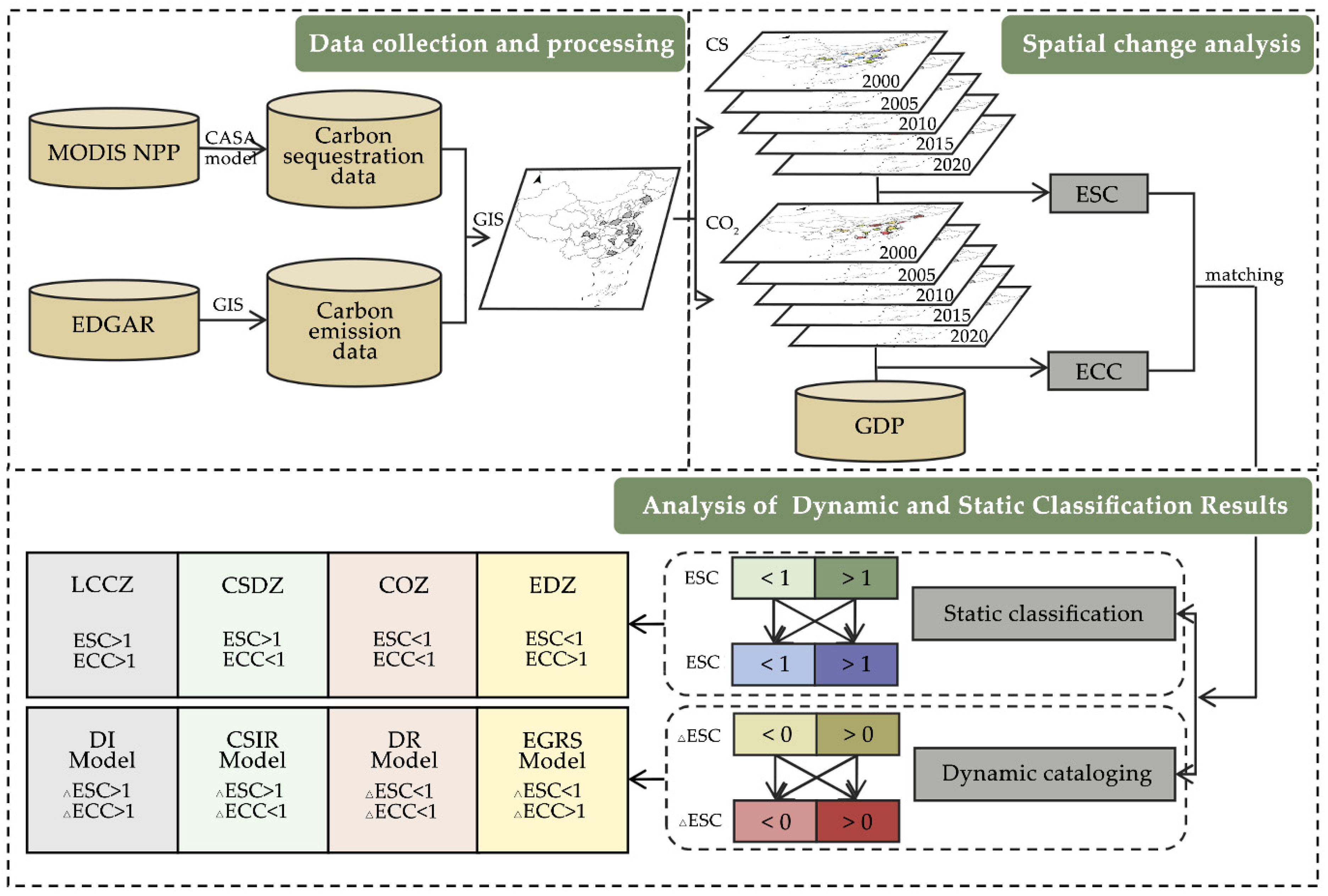

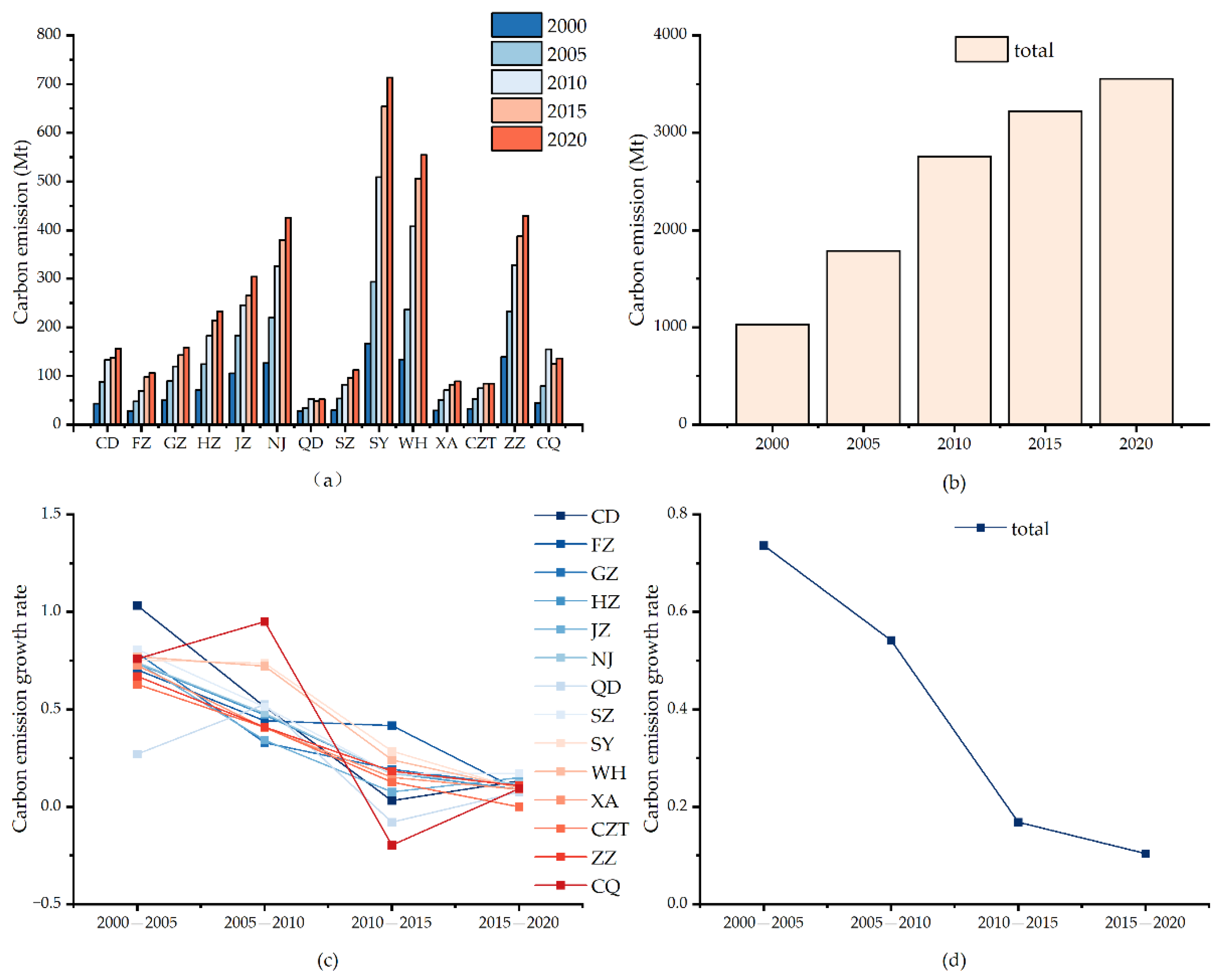

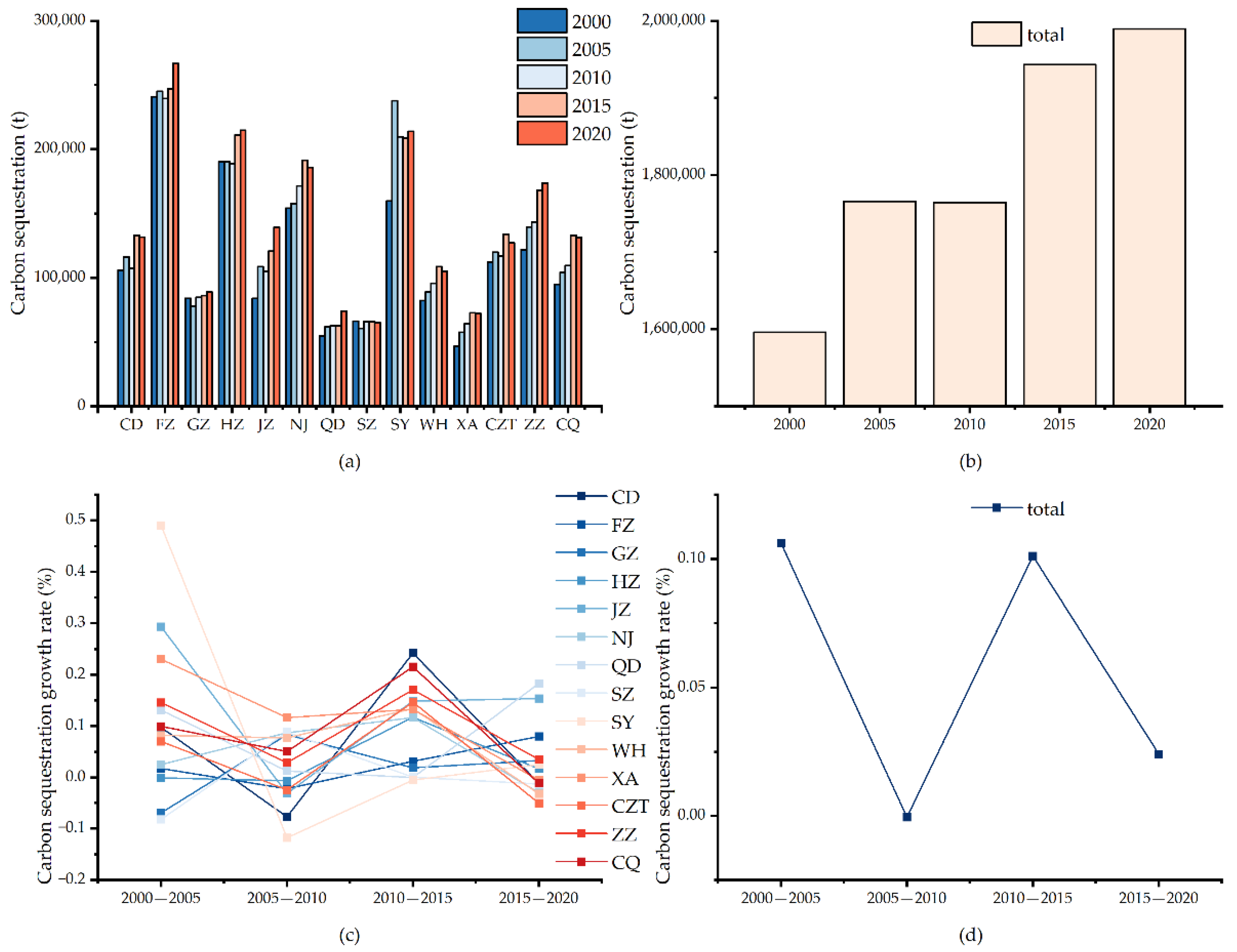

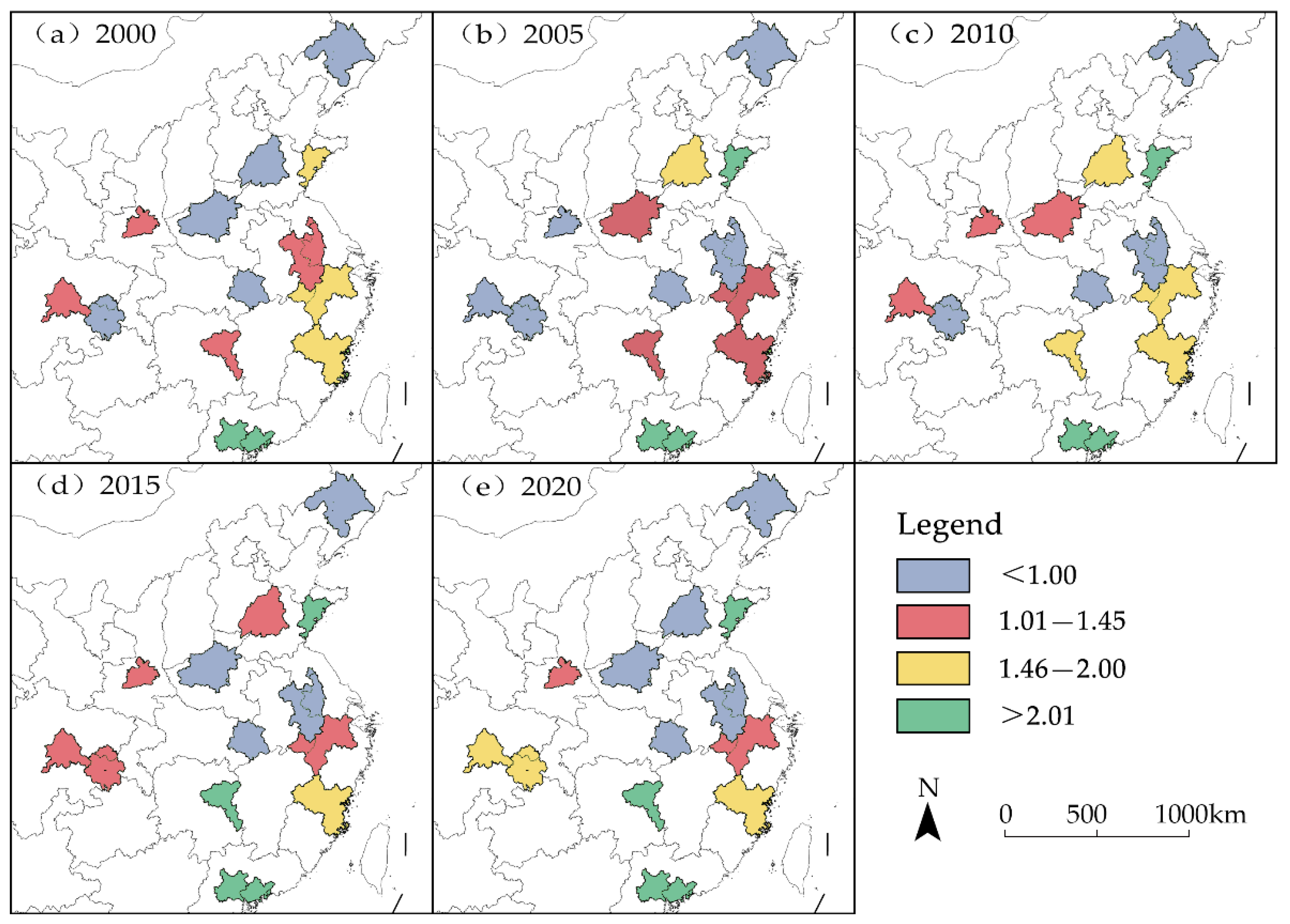

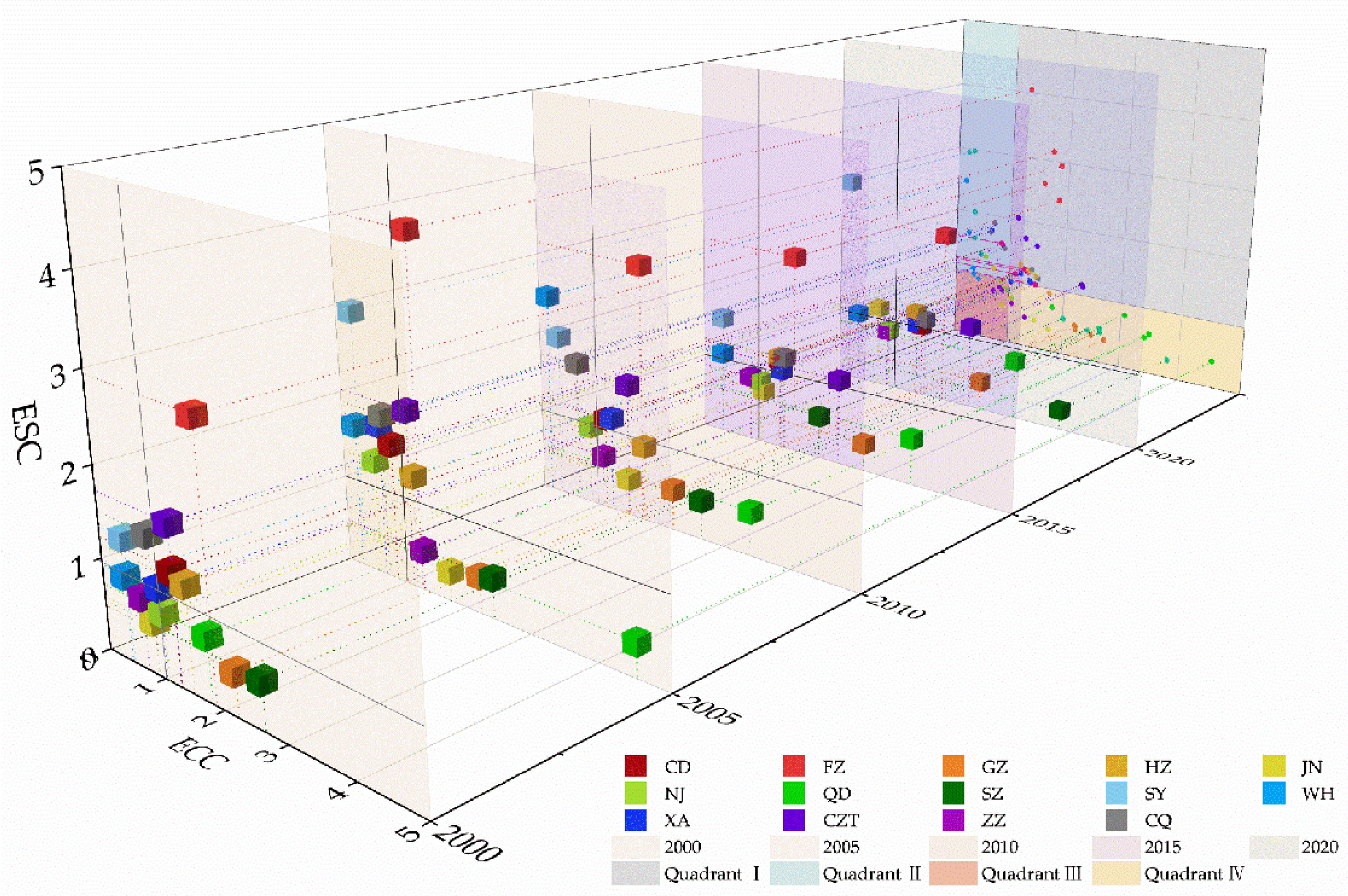

| Metropolitan Area | District | Approval Time | Area (10,000 km2) | THE GDP OF 2020 (Trillion Yuan) |
|---|---|---|---|---|
| Nanjing | Jiangsu Province | February 2021 | 6.6 | 1.48 |
| Fuzhou | Fujian Province | June 2021 | 2.6 | 1.00 |
| Chengdu | Sichuan Province | November 2021 | 2.64 | 6.8 |
| Chang-Zhu-Tan | Hunan Province | March 2022 | 1.89 | 1.75 |
| Xi’an | Shaanxi Province | April 2022 | 2.06 | 1.30 |
| Chongqing | Chongqing Municipality | August 2022 | 3.5 | 2.50 |
| Wuhan | Hubei Province | December 2022 | 5.78 | 2.63 |
| Shenyang | Liaoning Province | April 2023 | 7 | 0.66 |
| Hangzhou | Zhejiang Province | August 2023 | 2.2 | 3.33 |
| Qingdao | Shandong Province | October 2023 | 2.15 | 1.24 |
| Zhengzhou | Henan Province | October 2023 | 5.88 | 3.28 |
| Guangzhou | Guangdong Province | December 2023 | 2 | 4.23 |
| Shenzhen | Guangdong Province | December 2023 | 1.63 | 4.38 |
| Jinan | Shandong Province | January 2024 | 2.23 | 1.01 |
| Data Type | Data Source | Time Range | Spatial Resolution |
|---|---|---|---|
| Carbon Emission Data | Emissions Database for Global Atmospheric Research (EDGAR) | 2000–2020 | 0.1° × 0.1° |
| GDP Data | China GDP Spatial Distribution Grid Dataset | 2000–2020 | 1 km × 1 km |
| Net Primary Productivity (NPP) | NASA MOD17A3H Dataset | 2000–2020 | 500 m |
| No. | 1 | 2 | 3 | 4 |
|---|---|---|---|---|
| Static Classification | ECC > 1 ESC > 1 | ECC < 1 ESC > 1 | ECC < 1 ESC < 1 | ECC > 1 ESC < 1 |
| Type | LCCZ | CSDZ | COZ | EDZ |
| Quadrant | I | II | III | IV |
| No. | 1 | 2 | 3 | 4 |
|---|---|---|---|---|
| Static Classification | ∆ECC > 0 ∆ESC > 0 | ∆ECC < 0 ∆ESC > 0 | ∆ECC < 0 ∆ESC < 0 | ∆ECC > 0 ∆ESC < 0 |
| Type | DI Model | CSIR Model | DR Model | EGRS Model |
| Quadrant | I | II | III | IV |
Disclaimer/Publisher’s Note: The statements, opinions and data contained in all publications are solely those of the individual author(s) and contributor(s) and not of MDPI and/or the editor(s). MDPI and/or the editor(s) disclaim responsibility for any injury to people or property resulting from any ideas, methods, instructions or products referred to in the content. |
© 2025 by the authors. Licensee MDPI, Basel, Switzerland. This article is an open access article distributed under the terms and conditions of the Creative Commons Attribution (CC BY) license (https://creativecommons.org/licenses/by/4.0/).
Share and Cite
Liu, M.; Yu, Y.; Zhang, M.; Wang, P.; Shi, N.; Ren, Y.; Zhang, D. Carbon Balance Matching Relationships and Spatiotemporal Evolution Patterns in China’s National-Level Metropolitan Areas. Land 2025, 14, 800. https://doi.org/10.3390/land14040800
Liu M, Yu Y, Zhang M, Wang P, Shi N, Ren Y, Zhang D. Carbon Balance Matching Relationships and Spatiotemporal Evolution Patterns in China’s National-Level Metropolitan Areas. Land. 2025; 14(4):800. https://doi.org/10.3390/land14040800
Chicago/Turabian StyleLiu, Mengqi, Yang Yu, Maomao Zhang, Pengtao Wang, Nuo Shi, Yichen Ren, and Di Zhang. 2025. "Carbon Balance Matching Relationships and Spatiotemporal Evolution Patterns in China’s National-Level Metropolitan Areas" Land 14, no. 4: 800. https://doi.org/10.3390/land14040800
APA StyleLiu, M., Yu, Y., Zhang, M., Wang, P., Shi, N., Ren, Y., & Zhang, D. (2025). Carbon Balance Matching Relationships and Spatiotemporal Evolution Patterns in China’s National-Level Metropolitan Areas. Land, 14(4), 800. https://doi.org/10.3390/land14040800








